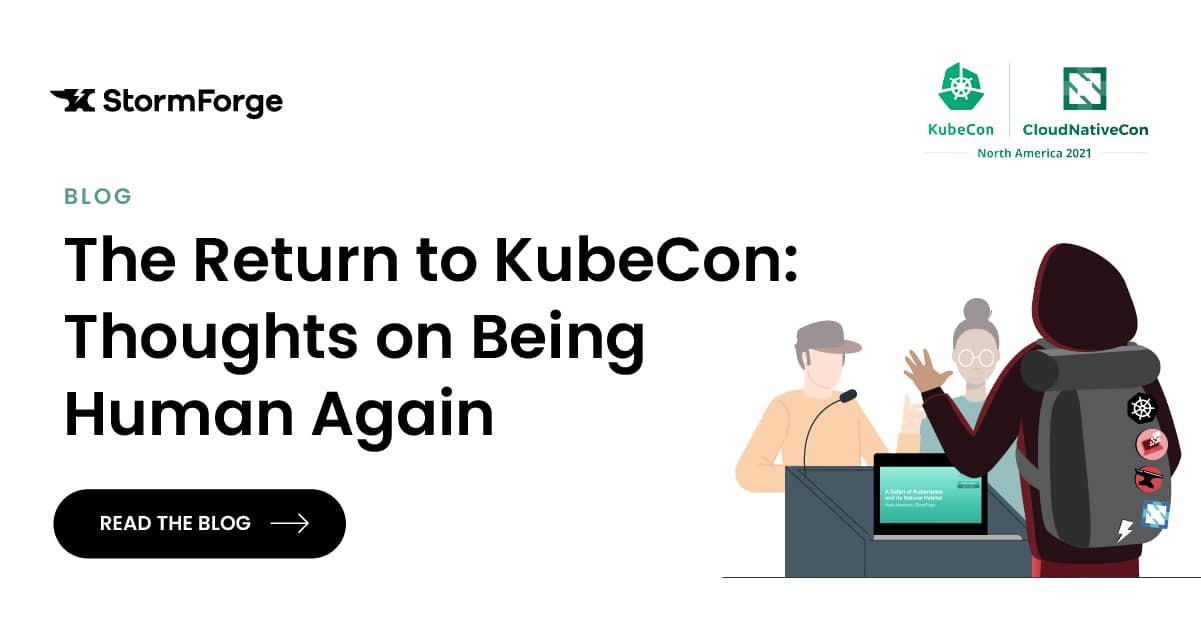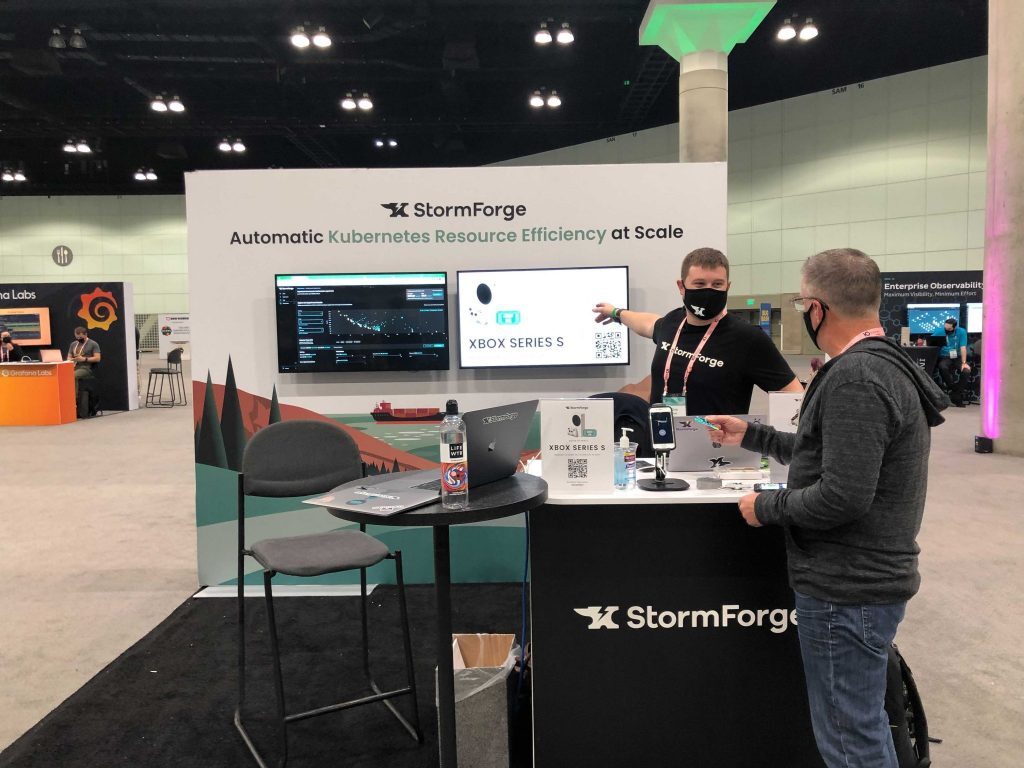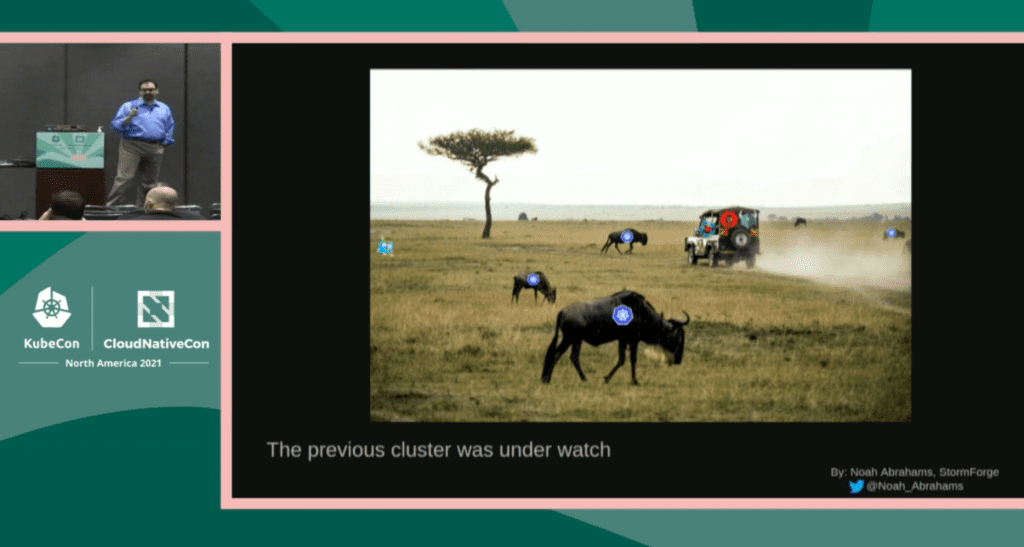

It was Los Angeles, so the chill in the air wasn’t from the weather. It was from the dual excitement and trepidation of returning to KubeCon in person, after a long necessary absence, while the world dealt with a global disaster. After two whole years, the urge to drive the community forward with a connection that wasn’t partially hidden behind a camera and a Zoom background was palpable. The biggest problem was… none of us knew how to do it. We’ve felt like a family in the past, and we’ve never been kept apart as a group for that long before.
In previous years, whether we were newcomers or those who had returned after a prolonged absence, there was always the collective community connection to latch onto for stability, like a handrail on a city bus. That grounded vibe made entering any conversation easier, and asking any question a little less intimidating. This time, however, we didn’t have that. We had to, as a group several thousand strong, simultaneously figure it out ourselves and also help each other figure it out. We air-high-fived, elbow bumped, and in some rare cases, even hugged, as we found our people once again, and reconnected one by one.
Whether it was the conversations we had in the vendor showcase, passing briefly in the hallway, going out for tacos, or at late-night karaoke, we rekindled the closeness that makes the Kubernetes and Cloud Native community the force that it is. But, we did it all while also thinking, “is this current scenario safe?”
It was both a wonderful and an odd experience, because despite how much we wished it was otherwise, there was and still is a global pandemic raging. It helped greatly knowing that everyone in attendance was vaccinated, and requiring everyone to wear masks went a long way to reducing our collective worry, but we all still knew there were risks associated. Many of the folks I spoke with were doing testing either daily or every other day, both during the conference and for the two weeks that followed. Knowing that others around you were taking the issue seriously went a long way towards helping re-establish the closeness of contact we all so desperately needed to get out of this event.
As for the LA venue itself, there were conflicting feelings. On the one hand, the venue felt oddly small, like there were less session rooms than expected. Many of the rooms were tucked off to the side, and on occasion larger rooms were populated with a handful of people and a pre-recorded talk, which did nothing to detract from the oddity of it. At the same time, the venue also felt unnecessarily large, partly because it was one long track leading off to another hall, which happened to contain the Vendor Showcase. Even though there were rooms along the way, it still felt like a serious hike to get to the vendors.

Related to that hike, attending as a vendor was a roller coaster of highs and lows. We started on Day 1, during what was to be the dedicated booth crawl, wondering, “where are all the attendees?” The placement of the vendor showcase was far enough out of the way that I had to ask for directions, and still got lost on the way. While expecting the normal deluge of people, instead receiving only a few dozen visitors left many vendors furious… until we realized the unexpected benefit. Every conversation on the show floor was a good one. Due to the compounding of minor barriers involved in getting to the show floor (mostly lack of signage and being nowhere near the other sessions), those who did make it out to the show floor were a much higher percentage of in-depth conversations than normal.
For those who’ve never worked a booth before, here’s some visibility into the vendor side of it. If you are a product or services company (as opposed to a purely informational booth, like for the various OSS projects), there’s typically a segment of time after any conference where you have to filter out the badge scans of those who are only vaguely interested but won’t actually do any business (or just came by because they liked your swag) from those who are actually interested in your offerings, as you work to drive your business forward. This takes both time and effort, and can often last for weeks or even months, depending on responsiveness. (Don’t pretend you haven’t also just ignored the deluge of post-conference emails… we all have.) If that initial filtering happens in October and November, you may strike up a good business discussion just in time for it to be put on hold over the holidays, and if you don’t get back together until January or February, it is entirely possible (read: likely) for people to forget what you were talking about in the first place. We’re only human, after all. By skipping that initial filtering phase, I can guarantee that conversations that happened on the show floor are already moving forward for many of the vendors, and the business impact will, despite how it looked on Day 1, be stronger than it would have been if there had been an additional 5x the number of people, just shopping for swag. So, having the show floor be a bit of a walk away ended up with unexpected advantages.
Speaking of going for a walk, LA in October is wonderful, and we couldn’t have asked for better weather. Outdoor dining abounded, and you could catch attendees outside their hotels on any evening. The all-attendee party held in a cordoned but outdoor setting felt intimate while still being open to the sky, and even though I personally was bit by not having my badge once (I should have known better), having that requirement meant knowing that everyone you were with had been fully vaxxed and gone through a health check that morning.
All in all, KubeCon/CloudNativeCon was a fantastic chance to reconnect with the Kubernetes family, but I didn’t go just to see people. I went to attend many sessions on community and growth, to feel the pulse of the ecosystem, and most importantly, to give my first on stage talk at KubeCon.
My talk was officially titled “A Safari of Kubernetes and its Natural Habitat”, and I gave it on Day 1, only about an hour after the opening keynotes ended. I mentioned in the talk that the entire idea sprang forth from a discussion of “What would be YOUR KubeCon keynote walk-on music?” but it quickly grew beyond that. At StormForge, we’ve continually pushed on the message of sustainability and ecological accountability in technology, specifically in cloud applications and what is perceived as an infinite amount of resources for them to grow into, as long as you’ve got the budget to back it up. That, however, ends up as a waste of both financial and natural resources, and I really wanted to draw some analogies between the natural world (Wildebeest being eaten by lions) and the technological world (“Our AWS bill is WHAT?!”). This ended up serving multiple purposes.

First of all, the talk was designed to be memorable. If people keep talking about how absurd it was that “This guy got on stage and did an entire talk with a Sir David Attenborough impersonation!”, then I’ve done my job properly, partly because they’ll also remember that “pets vs cattle” can be a dangerous analogy, that you have to keep on eye on your transition to production, or that unlimited quotas can kick your cloud bill into high gear. Secondly, I wanted it to be fun for the audience. I heard many of you stifling laughter at my dry jokes and nature special cliches, and I barely stopped myself from breaking a couple of times, but that’s because I also wanted it to be fun for me. Too many talks are presented in the context of “How much info can we fit on the slides, and cram into thirty minutes?”, and while there’s certainly a need for sharing that information, this is a tech show, not an academic conference. You are not trying to present the entirety of years worth of research as quickly as possible, to refuel your grant. In conferences like this, there needs to be a variety of talks (not saying traditional slide-based talks are bad), and nowhere is that shown clearer than in the presence of the 101 track, which my talk was part of. These talks need to be accessible, and that also means the widest variety of possible presentation styles, not just what’s on your slide. The talk I personally remember the most and still talk about, from any KubeCon, was Justin Garrison’s talk in Austin, showing how Kubernetes worked with a spreadsheet and balloon animals! Obviously, talks with live demos play strongly into this ideal of variety in learning, as do panel discussions, but the more we can think outside the box, the more we can engage with audiences we may have previously missed, and that type of inclusion and welcoming nature is a core tenet of the Kubernetes and cloud native ecosystem.
After I finished giving my talk, I was riding high. This was partly because I found it easier to give a performance than a presentation (a subtle distinction which some of you may consider if you are submitting talks in the future), but also because it was one of the first talks of the conference and I was still riding the wave of energy and excitement from the opening keynotes. The session wasn’t, however, without its own set of problems. We found out too late that the audio for the online part of the hybrid presentation was too low, and those watching online could barely hear me (thankfully, this is rectified in the recording). This brings up a general problem with hybrid events, namely, there is no way for someone watching online to have the same type of communication and connection with a speaker compared to someone who is physically in the room. The talk moderators typically do a great job of relaying questions, but it’s lacking the immediacy and feedback of being able to make eye contact and feel viscerally if your question is understood or your answer is received. Short of having rooms full of robots with tablets for faces, however, I don’t see a way to solve that anywhere in the near future.
While we’re talking about Hybrid events, there’s tremendous effort being put in by many to simulate a hallway track in the virtual world, and we can’t discount the amount of work they’re putting in and the positivity they’re bringing to the virtual side of things… but it’s also still not the same. Serendipity is important, and one of the largest factors of the hallway track is that you don’t have to log in or explicitly join it. You’ll find yourself unexpectedly joining it, as you move from session to session, and sometimes that human connection that is as simple as 30 seconds of saying Hi between rooms is what leads to a new project, or a business deal, or a new job. The hallway track happens not just outside session rooms, but on the way to lunch, waiting for your Lyft, or in the hotel lobby, and there is just no way to replicate that in a virtual setting.
So, the long and short of it is that despite a global pandemic, and an imperfect event, we got a lot of positive impact out of KubeCon. I enjoyed giving my talk, and based on feedback, a lot of you enjoyed it as well. Hybrid events still need work, but as can be expected from a community as caring as this one, people are stepping up to carry the torch and make the situation as excellent as possible, for everyone involved. We found pleasant surprises along the way, and I for one enjoyed it immensely. There’s no substitute for that human connection, and it was good to finally be back.
StormForge is the leader in cloud native application optimization, making it easy to achieve cloud efficiency without being a Kubernetes expert. StormForge combines enterprise-grade performance testing with machine learning to automatically reduce cloud costs and improve application performance. Contact us to speak with a Certified Kubernetes Administrator and see how StormForge can help you.
We use cookies to provide you with a better website experience and to analyze the site traffic. Please read our "privacy policy" for more information.